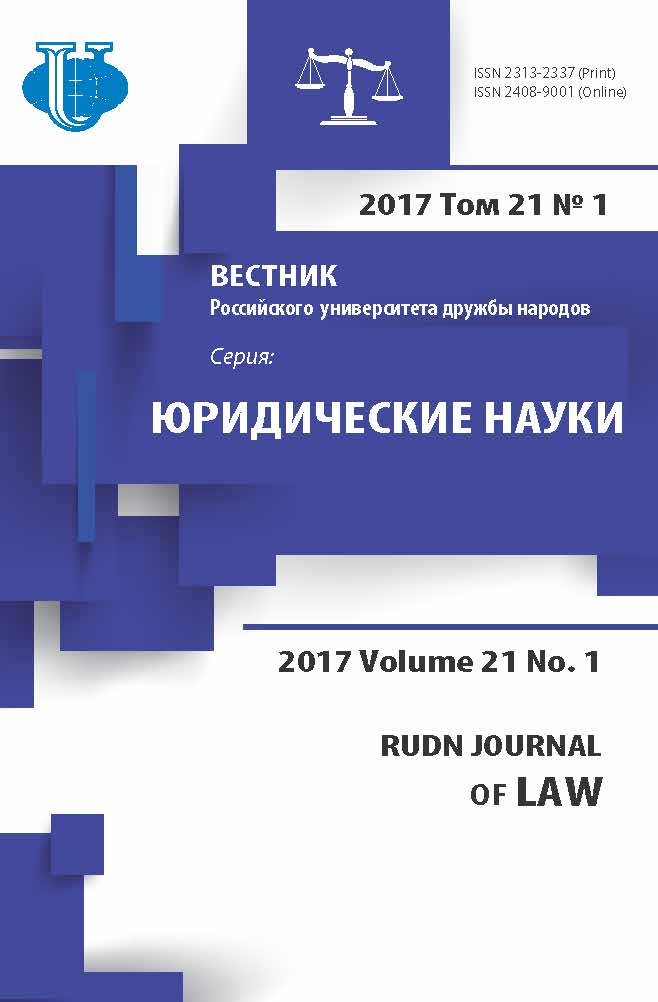Outer Space and Common Heritage of Mankind: Challenges and Solutions
- Authors: Siavash M.1
-
Affiliations:
- RUDN University
- Issue: Vol 21, No 1 (2017)
- Pages: 102-114
- Section: Articles
- URL: https://journals.rudn.ru/law/article/view/16091
- DOI: https://doi.org/10.22363/2313-2337-2017-21-1-102-114
- ID: 16091
Cite item
Full Text
Abstract
The purpose of this research is to provide a comprehensive international legal analysis of the concept of common heritage of mankind as it exists in international space law. In this article scientific methodological approach was used which facilitate determination the whole canvas of the research, identify the main aspects and concepts of the study. The author also widely investigated the concept of common heritage of mankind in the practice of States and international organizations and bodies. Since mankind succeeded to access outer space and opened the window of this infinite realm, the effort was made to systematize spatial activities by codification and adoption numerous international treaties and declarations. One of the significant result of these efforts was the Agreement Governing the Activities of States on the Moon and Other Celestial Bodies that adopted by the United Nations Committee on the Peaceful Uses of Outer Space by consensus on 5 December 1979, declares the Moon and other celestial bodies to be the common heritage of mankind. This Agreement has never been ratified by any State that engaged in self-launched manned space exploration or has plans to do so and thus has an insignificant effect on spatial activities. This article analysis the concept of common heritage of mankind that consists of five elements: non-appropriation, international management of resources, sharing of financial and technological benefits, reservation for peaceful purposes and reservation for further generations. It is shown that the Moon Agreement applying the concept of common heritage of mankind to outer space, Moon and other celestial bodies which has been presented by developing countries to preserve essential resources, always been associated with some problems. Also, on the one hand, there is an attempt to scrutinize these obstacles that prevent applying this concept by paying attention to its challenges. On the other hand, author presents some solutions to strengthen this concept in outer space legal system and motivate space powers to join the Agreement Governing the Activities of States on the Moon and Other Celestial Bodies.
About the authors
Mirzaee Siavash
RUDN University
Email: siavash.mirzaei1988@gmail.com
Law Institute 6, Miklukho-Maklaya st., Moscow, Russia, 117198
References
- Bhat SB. The Concept of Common Heritage of Mankind in the Governance of the Moon - An Insight into Article 11 of the Moon Agreement. Legal Opus. 2007;1:92-107.
- Zhukov GP, Abashidze AKh. International space law. Moscow: RUDN; 2014. 524 p. (In Russian).
- Ervin S. Law in a Vacuum: The Common Heritage Doctrine in Outer Space Law. Boston College International and Comparative Law Review. 1984;7(2):403-431.
- Nandakumar S. Common Heritage of Mankind - Property Rights, in the Wake of Commercial Use of the Moon and Other Celestial Bodies. In: Proceedings of the Forty-Eighth Colloquium on the Law of Outer Space. Reston: American Institute of Aeronautics and Astronautics. 2005. p. 308-317.
- Rana HS. The Common Heritage of Mankind &(and) the Final Frontier a Revaluation of Values Constituting the International Legal Regime for Outer Space Activities. Rutgers Law Journal. 1994;26(1): 225-250.
- Goldie LFE. A Note on Some Diverse Meanings of the Common Heritage of Mankind. Syracuse Journal of International Law and Commerce. 1983;10(1):69-112.
- Arnold RP. The Common Heritage of Mankind as a Legal Concept. The International Lawyer. 1975;9(1):153-158.
- Goldie LFE. A General International Law Doctrine for Seabed Régimes. The International Lawyer. 1973;7(4):796-824.
- Gorove S. Concept of Common Heritage of Mankind Political Moral or Legal Innovation. The San Diego Law Review. 1972;9(3):390-403.
- Pardo A. Third World Lecture 1984. Ocean Space and Mankind. Third World Quarterly. 1984;6(3):559-575.
- Jakhu R. Legal Issues Relating to the Global Public Interest in Outer Space. Journal of Space Law. 2006;32(1):31-110.
- Dietrich GB. Extending the Principle of the Common Heritage of Mankind to Outer Space. Montreal, Quebec: McGill University; 2002. 91 p. Available from:http://digitool.library.mcgill.ca/webclient/StreamGate?folder_id=0&dvs=1485783073303~907 [Accessed 18th November 2016].
- Hearsey ChM. A Review of Challenges to Corporate Expansion into Outer Space. In: AIAA SPACE Conference & Exposition 9 - 11 September 2008. San Diego, California. Available from: http://www.astrosociology.org/Library/PDF/Hearsey_CorporateExpansion.pdf [Accessed 18th November 2016].
- Shackelford SJ. The Tragedy of the Common Heritage of Mankind. Stanford Environmental Law Journal. 2009;28(1). Available from: https://ssrn.com/abstract=1407332 [Accessed 18th November 2016].
- Gabrynowicz JI, Serrao JE. An Introduction to Space Law for Decision Makers. Journal of Space Law. 2004;30(2):227-233.
- Cherian G, Abraham J. Concept of Private Property in Space - An Analysis. Journal of International Commercial Law and Technology. 2007;2(4):211-220.
- Brandt-Erichsen, David; Brief History of the L5 Society. Available from: http://www.nss.org/settlement/L5news/L5history.htm [Accessed 18th November 2016].
- Jacobs B. The Future of Energy Lunar Resource Management and the Common Heritage of Mankind. Georgetown International Environmental Law Review. 2012;24(2):221-244.
- Zhao Y. An International Space Authority: A Governance Model for a Space Commercialization Regime. Journal of Space Law. 2004;30(2):277-296.
- Payoyo PB, editor. Ocean Governance: Sustainable Development of the Seas. Tokyo, New York, Paris: United Nations University Press; 1994. Available from:http://archive.unu.edu/unupress/unupbooks/uu15oe/uu15oe00.htm#Contents [Accessed 18th November 2016].
- Hobe S. Current and Future Development of International Space Law. Available from: http://www.unoosa.org/pdf/publications/st_space_28E.pdf [Accessed 18th November 2016].
- Taylor P. The concept of the common heritage of mankind. In: Fisher D, editor. Research Handbook on Fundamental Concepts of Environmental Law. Cheltenham, UK, Northampton, MA, USA: Edward Elgar Publishing; 2016. p. 306-334.
Supplementary files















